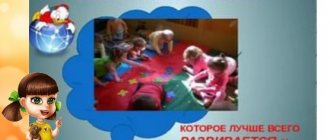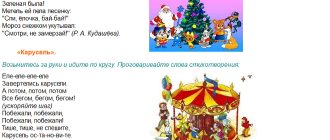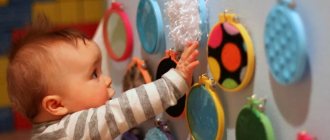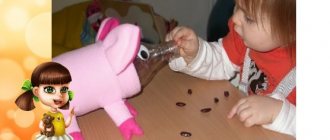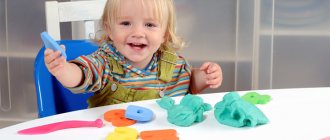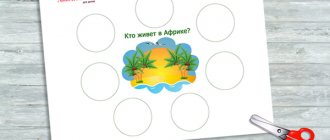According to M. Montessori, the most important task between the ages of 0 and 3 years is sensory development. During this period, children explore the world using various senses, and the main sources of information are vision and tactile perception. In order for the baby to actively develop, parents must create an environment for the child in which he could receive new and vivid sensory experiences. Sensory boxes will help make the learning environment at home even more enriched. What to fill a baby's sensory box with? How to play with her? At what age can you start playing games like this? We will answer these and other questions in this article.
What is a sensory box?
Sensory boxes are containers with various sensory fillings (liquids, bulk materials, jelly, paste, toys, etc.). This is an extremely useful and multifunctional toy for children of early and preschool age. The baby can feel small objects, pour them in, hide them, and come up with his own story. Playing with a sensory box helps develop a child's fine motor skills, attention, imagination and speech.
It is easy to make a sensory box for a child with your own hands with minimal material costs.
This educational toy can be based on any container: box, container, basin, pan. The main thing is that the child feels comfortable playing with it. Next, the container is filled with various materials (depending on the theme of the sensory box and the age of the child). Usually these are cereals, pasta, pebbles, natural materials, water, jelly, cotton wool, etc. To make it more interesting for your baby, put small toys and tools (shovels and scoops) in the “box”.
Sensory development of children of primary preschool age through gaming technologies
From the experience of working as a kindergarten teacher. Sensory development of younger preschoolers through gaming technologies. Presentation
Good afternoon, dear teachers!
My name is Kapsomun Svetlana Borisovna. I am a teacher at the Child Development Center of kindergarten No. 10. Today I want to share my experience of working with children of primary preschool age. The topic of my message: “Sensory development of children of primary preschool age through gaming technologies” Having been born, a child is able to see, hear, feel heat and cold, i.e. perceive the endless variety of the environment, then he begins to actively explore the world around him. The source of a preschooler’s knowledge is sensory experience. This means that we must remember that the main thing at this age is to enrich the child’s experience, which is necessary for a full perception of the world around him, and first of all, it is to enrich his ideas about the external properties of objects. But if assimilation occurs spontaneously, without reasonable pedagogical guidance, it often turns out to be superficial and incomplete. This is where sensory development comes to the rescue. (Slide) A child’s sensory development is the development of his perception and the formation of ideas about the external properties of objects: their shape, color, size, position in space, as well as smell, taste, etc. The importance of sensory development in early preschool age is difficult to overestimate. Professor N.M. Shchelovanov called the younger age the “golden time” of sensory education. While working with young children, I noticed that children come to kindergarten without sensory experience. They have poorly developed not only sensory abilities, but also fine motor skills and the eye. They do not know the color, shape, quality of the object. Therefore, I decided to pay more attention to this problem, to systematically and systematically include it in all moments of the baby’s life, primarily in the processes of learning about the surrounding life: objects, their properties and qualities. (Slide) The goal of my work was: increasing the level of sensory development of children of primary preschool age through gaming technologies. The tasks that I set for myself: • Teach children to perceive and imagine objects and phenomena, analyze them, compare, generalize through play. • Use the main types of gaming technologies in your work with children to form sensory standards for younger preschoolers. • Develop independent activity skills, increase children's self-esteem and self-confidence. • Unite the children's team. Therefore, in my work, I first approached the issue of creating conditions for the sensory development of young children. To do this, I diversified the developmental subject-spatial environment in the group, created a sensorimotor corner, I try to develop and improve all types of perception in children, enrich their sensory experience through gaming technologies, and I also work with parents to increase knowledge on sensory development and education of preschoolers. (Slide) Creating a developmental environment. I pay special attention to creating a subject-development environment, since children are in kindergarten all day, they grow, develop, actively communicate with each other and with others, and learn about the world through physical interaction with objects and people. Therefore, I try to organize the life of children in the group so that they feel comfort, love from adults and have a need for communication. I select the group’s furnishings in such a way that they reflect the variety of colors, shapes, sizes, materials, and the harmony of the surrounding world. With its brightness, novelty, and unusualness, the created environment encourages children to explore it, act in it, and develop initiative and creativity. (Slide) In the group, I have created a sensorimotor corner, where there are various manuals and games on the sensory development of children of primary preschool age. (Slide) When introducing children to sensory standards, I use a game character. In free activities I include games: “Sort out vegetables and fruits”, “Gegetable shop”, “Let's set the table for guests”, where children lay out dishes of different sizes and colors. “Dress up a doll”, where children dress up dolls in colorful clothes. (Slide) Considering that play is the main form and content of organizing children’s lives, this is the most favorite and natural activity of younger preschoolers. I carry out the sensory development of children through gaming technologies, since gaming technologies are the foundation of all preschool education. (Slide) The concept of “game pedagogical technologies” includes a fairly broad group of methods and techniques for organizing the pedagogical process in the form of various pedagogical games. This is the consistent activity of the teacher in selecting, developing, preparing games, including children in gaming activities, implementing the game itself, summing up the results of gaming activities. The main component of gaming technology is direct and systematic communication between the teacher and children. The goal of gaming technology is not to change the child or remake him, but to give him the opportunity to “live” situations that excite him in the game with the full attention and empathy of an adult. (Slide) Gaming technologies that I use in my work: (Slide) 1) Dienesh blocks. 2) Cuisenaire sticks. 3) Carpet printing. 4) Math tablet. 5) Montesori technology. Now I’ll tell you a little about each technology. Dienes blocks . (Slide) Dienesh's logic blocks are a set of figures that differ from each other in color, shape, size, thickness; they can be used from 2 years of age. To make it interesting for your child to play and study, you can use your favorite toys and special aids with bright pictures. Games with blocks contribute to the development in children: memory, logical thinking, combinatorics, attention. Cuisenaire Sticks (Slide) “Cuisenaire Sticks” or “Colored Numbers” are a good material for developing creativity, logical thinking, attention, memory, and the ability to model and design. The set contains tetrahedral sticks of 10 different colors and lengths from 1 to 10 cm. Used from 2 years. At the initial stage, I used Dienesh sticks and blocks as playing material. Children play with them as with ordinary sticks or construction sets, and along the way they get acquainted with colors, sizes and shapes. Then I began to use it in the classroom, using special aids with bright pictures. Based on the image, the child lays out sticks and blocks like a mosaic and gets a three-dimensional picture. Carpet printing . (Slide) Carpet printing is used when getting acquainted with the objective world, when teaching spatial orientation, telling fairy tales, and modeling from geometric shapes. Mathematical tablet . (Slide) A mathematical tablet allows you to teach children how to navigate on a plane. Children develop fine motor skills and visual perception. M. Montessori technology . (Slide) According to the Montessori method, the environment is divided into 4 zones: exercises in practical life, sensory, mathematics, speech development, and sets of objects to determine: size, color, shape, sound, tactile sensations, smell, weight, all made from familiar materials to kid. Our material for work is simplified and close to our capabilities, this is something that you can touch and experiment with: lids, clothespins, plates, jars, Kinder Surprise eggs and various cereals. It has long been noted that children are more interested not in toys, but in household items, and they really enjoy pouring water from various jars, sorting, pouring, sorting cereals. These are games such as “Find the treasure”, “Cinderella”, “Feed Timoshka”. Games with Marbles pebbles - colorful happiness for children! (Slide) Marbles and decorative pebbles are a bright, varied material in shape, color, and texture. They got their name from the English word, i.e. marble. I use this technology both in group classes and individually. When working, I carry out the following tasks: 1. I develop fine motor skills, visual-motor coordination, attention, memory and thinking, the child’s imagination 2. At the same time, I cultivate a positive emotional attitude in the child during the lesson. Working with parents .
(SLIDE) It should be noted that all the organized work would not have been so fruitful and would not have given the desired effect if I had not been able to interest my parents. Consultations were organized for parents: “What is sensory skills, and why does it need to be developed?” “Sensory abilities of a child”, “Raising a child’s sensory culture”; master class: “Learn by playing!”, “Journey to the world of Childhood!” Conversations, folders - moving. And parents become active participants in the educational process. (Slide) Non-traditional equipment made by parents. Although modern manufacturers offer many games and toys for developing fine motor skills, I pay special attention to homemade games and non-traditional play equipment. All this was done together with parents: various manuals, educational games, exercise equipment. All games are aimed at developing fine motor skills. Thus: the sensory development of younger preschoolers is one of the important areas in the personal development of children and the basis for the successful intellectual development of a child. And the use of gaming technologies helps to acquire knowledge, skills and abilities that the child will carry throughout his life. I would like to end my message with the words of V.A. Sukhomlinsky “A game is a huge bright window through which a life-giving stream of ideas and concepts of the surrounding world flows into the spiritual world of a child.” Thank you for your attention! Presentation on the topic: Sensory development of children of primary preschool age through gaming technologies
We recommend watching:
Sensory adaptation - didactic skirt Art therapy in working with children Didactic game with your own hands to develop imagination in preschoolers Games for the sensory development of children in kindergarten
Similar articles:
Sensory education of children of primary preschool age in preschool educational institutions
Filling sensory boxes
The following can be used as the main filler for the sensory box:
- Cereals (rice, peas, millet, lentils, beans, buckwheat, semolina, etc.);
- Coffee;
- Pasta;
- Stones;
- Shells;
- Sand;
- Nuts;
- Cones;
- Dry leaves;
- Jelly;
- Water;
- Snow;
- Yarn;
- Textile;
- Vatu;
- Decorative stones for aquariums.
The more different sensations your baby gets, the more benefits for his development. Try to regularly change the contents of the sensory box to keep your child interested in playing with it.
Additional items:
- Animal figurines;
- Small toys;
- Constructor;
- Cubes;
- Letters and numbers.
Tools for playing in the sensory box:
- Bowls;
- Glasses;
- Spoons;
- Scoops;
- Rake;
- Tweezers;
- Magnifier;
- Funnel;
- Sieve.
Sensory education in children 2-3 years old
In order to purposefully influence the sensory skills of preschoolers, it is necessary to know the main stages of sensory development, be able to diagnose its level and correlate it with age-related characteristics. Among them are the following:
- Getting to know an object through perception through the senses. The child puts it into his mouth, tastes it, feels it, smells it, evaluates its shape and size.
- Formation of skills to correlate the spatial arrangement of objects, connect objects and their parts. The child evaluates the sizes of objects and their relationships. To do this, you need to teach children to put one object into another (games with a pyramid work well), string beads on a cord, and push small objects into various holes. The child becomes familiar with composite objects, with the concept of the whole and parts. Games with large puzzles, cut-out pictures, and construction sets of 2-4 elements will help him with this. At the first stage, the child is able to assemble a matryoshka doll from 2 elements.
- Mastering ways to practically distinguish the properties of objects. A preschooler learns to compare two similar objects through practical actions: putting one on top of the other, the relationship between shape and color. At the second stage, the child is able to assemble a matryoshka doll from 3 elements.
- Formation of manipulative actions with an object based on repeated repetition. After practical manipulations with an object, the child is able to visually correlate the size and shape of objects using only mental operations. He can group objects according to one characteristic, select 3 objects according to a given pattern, and is able to sort objects from smallest to largest. At this stage, the preschooler assembles a five-seater nesting doll.
- Complicating the conditions for performing actions that require correlation according to one of the characteristics. The child groups objects according to several characteristics, is able to correlate 6 or more colors with each other, and visually selects a pair of objects according to given characteristics.
- Using learned actions in solving practical and cognitive problems. The child is able to reproduce acquired knowledge and skills, differentiate the properties of objects, and apply subject standards in solving assigned problems. At this stage, a 3-year-old child can correctly assemble a pyramid of 8 rings in descending order of their size.
Options for sensory boxes for children from 6 months
You can start playing with the sensory box as soon as your baby learns to sit. It is best to fill a sensory box for your baby with large and non-traumatic materials, for example, fabric, ribbons, pompoms, balls, sponges, cubes. You can also supplement it with various musical toys (bells, rattles) and something rustling (polyethylene, parchment paper).
If your baby is still small, use larger objects to fill the sensory box and carefully monitor how he plays.
For children over one and a half years old, you can use sensory boxes with cereals. At an early age, interest in small objects is especially great. Your baby will be happy to find hidden objects in the cereal. They can later be sorted by color or shape. In addition, playing with a sensory box can become training for instrumental actions: the ability to hold a spoon, pouring, and so on.
To make the filling of the sensory box brighter, you can color the rice at home. To do this, add a few drops of food coloring and 1 tablespoon of alcohol to a bag of rice (this is needed to fix the paint; the alcohol will evaporate quickly). Seal the bag tightly and stir to distribute the color evenly throughout the rice. Open the bag and wait for the cereal to dry.
If you and your child are learning the names of colors, then colored sensory boxes can be a good tool for practicing. Place different items of the same color into a container. When playing with such single-color sensory material, the baby will quickly remember the desired color.
The use of various tools and tools allows you to diversify games with the sensory box. Invite your child to play with the sieve and sift the semolina. To make it more interesting, hide small toys, pebbles or larger grains in the cereal. Using a sieve, the child must separate them from the semolina. With the help of such a game you can quickly master the concepts of “big” and “small”.
Sensory boxes filled with water cause genuine delight among children. With the help of a sieve and spoons, the baby can remove floating and sinking objects from the water, pour water into glasses, and make boats from molds and other available materials. You can add a little paint to the water - this will make playing even more fun and interesting.
Preschool children (over 3 years old) will be interested in themed sensory boxes. With their help, the child will learn new things about the world around him in a playful way. Such games are also very useful for the baby because they perfectly develop memory, attention, thinking and imagination. Here are some examples of themed sensory boxes:
- "Space"
- "Zoo"
- "Farm"
- "North Pole"
- "Construction"
The concept of sensory
“The child’s mind is at the tips of his fingers” - the words of the Soviet teacher V. Sukhomlinsky accurately reflect the tasks of raising a preschooler. In early childhood (from 1 to 3 years), development occurs through objective activity, in which imaginative thinking is formed. It is important for children to taste an object, feel its structure, and touch the surface. By interacting with surrounding objects, the child learns to perceive and analyze information. The senses and corresponding analyzers help him in this:
Through these systems, ideas about the surrounding reality are formed, which are enshrined in sensory standards - generally accepted properties of objects. Such standards are shapes, colors, size, taste, sound level, temperature.
The sensory system of a preschooler includes two interconnected aspects:
- Mastering ideas about the properties and relationships of objects. The child is looking for new ways to interact with previously unknown objects.
- Mastering new perceptual actions that allow you to more fully perceive the world around you. The child can perform operations not with objects, but with symbols, and becomes able to solve simple problems in his mind, without resorting to trial and error.
Sensory development allows:
- enrich your vocabulary;
- form the correct structure of speech;
- improve cognitive mental processes: memory, attention, thinking, perception;
- develop imagination;
- obtain complete information about the surrounding reality;
- improve communication skills.
A child who has a developed system of perception and processing of information is able to navigate perfectly in the conditions of the modern world.
